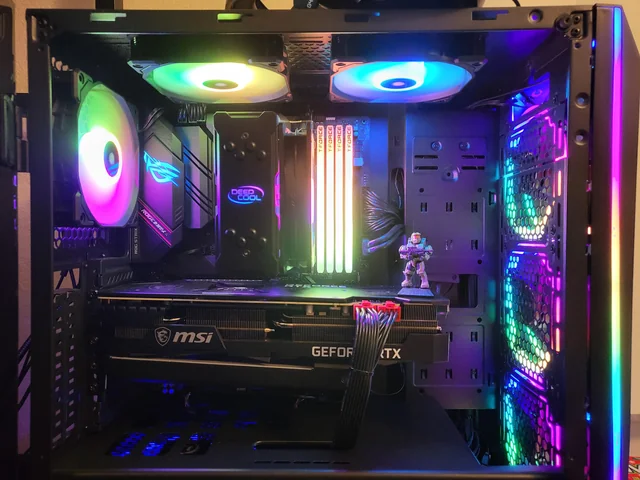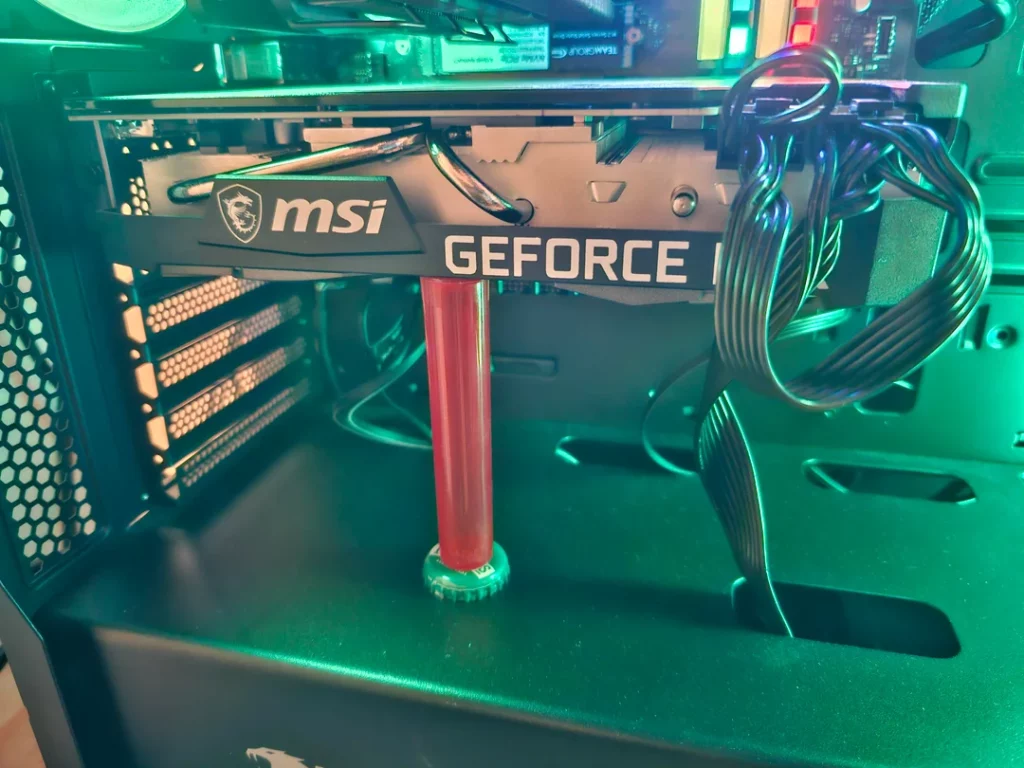To stop GPU sagging, use a support bracket or vertical mount to hold the card in place, and ensure all screws are tight. Regularly check and maintain connections to prevent the GPU from drooping.
Actually, GPU sagging is when a graphics card bends down due to having a lot of its weight, and there are chances that the slots sit in and get damaged. Let’s have a detailed look below!
Before Explaining, You Should Know What GPU Sagging Is!
What Does GPU Sag Mean?
GPU sag refers to the downward bending or tilting of a graphics card (GPU) inside a computer case. This typically happens due to the weight of the GPU, which can cause the card to droop over time if not properly supported. Understanding what GPU sag means is crucial for addressing and preventing it effectively. When a GPU sags, it can lead to physical strain on the GPU’s connection points and the PCIe slot, potentially resulting in damage over time. Recognizing the signs of GPU sag and knowing its implications can help in taking the necessary steps to correct it.
Explore This: Is BeamNG CPU or GPU Intensive? – Boost Your Setup In 2024!
What Causes GPU to Sag?
Several factors can cause GPU sag. Primarily, the heavy weight of modern GPUs can strain the PCIe slot and the card itself. Additionally, a poorly designed or inadequate case that does not provide sufficient support can exacerbate the problem. In some cases, the mounting screws may become loose, further contributing to the issue. The combination of these factors results in the GPU gradually bending downward, causing potential damage if left unchecked. Ensuring the proper support and installation of your GPU can help mitigate these risks.

Must Read: Can I Bring A GPU On A Plane? – 2024 Rules!
What Happens When GPU Sags? – GPU Sag Symptoms!
- Visible Tilt or Droop: The GPU noticeably tilts or droops within the case, indicating a lack of proper support.
- Physical Damage: Over time, sagging can cause physical damage to the GPU or motherboard, such as bending the PCB or damaging the PCIe slot.
- Poor Connections: Sagging can lead to poor connections between the GPU and the motherboard, resulting in unstable performance.
- Performance Issues: Users may experience reduced performance, with potential frame rate drops or inconsistent gameplay.
- System Instability: The system may become unstable, leading to random crashes or freezes.
- Blue Screens: Severe sagging can cause hardware failures that trigger blue screen errors, indicating critical system issues.
- Increased Stress on Components: Continuous sagging places additional stress on the GPU and motherboard, potentially shortening their lifespan.
Read Also: Do GPU Fans Always Spin? – Having Glitches While Playing?
Steps to Stop GPU from Sagging – Fix it, Now!
1. Use a GPU Support Bracket
GPU support brackets are designed to hold the GPU in place, preventing it from sagging. These brackets come in various designs and can be easily installed within your case to provide additional support and stability.
2. Reinforce with a Vertical GPU Mount
If your case supports it, mounting the GPU vertically can eliminate sag. Vertical mounts shift the weight distribution, reducing the strain on the PCIe slot and providing a more stable configuration for your GPU.
3. Tighten Screws and Connections
Ensure all screws and connections are secure to provide maximum support. Regularly checking and tightening these connections can help prevent the gradual loosening that contributes to sagging over time.
4. Use Cable Ties or String
As a temporary solution, you can use cable ties or string to support the GPU from above. This method can provide quick relief from sagging while you seek a more permanent solution, such as a support bracket or vertical mount.
Also Check Do Both Monitors Need To Be Connected To The GPU?
How Can I Prevent My GPU from Sagging in the Future?
To prevent future sagging, regularly check the tightness of screws and connections. Investing in a sturdy case with proper GPU support or using a support bracket from the beginning can also help. Avoid moving your PC frequently to minimize stress on the GPU and other components. Additionally, choosing a case with built-in support features can provide long-term stability for your GPU.
Have You Checked? Is Tarkov GPU or CPU Intensive
How Often Should I Update My GPU?
Updating your GPU doesn’t directly relate to preventing sag, but staying current with hardware can ensure better performance and stability. Generally, a GPU should be updated every 3-5 years depending on your usage and the advancements in technology. Regular updates can provide enhanced performance, better support for new applications, and improved energy efficiency. However, addressing physical support and installation practices remains essential regardless of the GPU’s age.
Do You Know: Is Elden Ring GPU Intensive?
Is GPU Sag Bad?
Yes, GPU sag can be detrimental. It can cause physical damage to the GPU and motherboard, lead to poor performance, and increase the risk of system instability. Addressing GPU sag promptly is crucial to maintaining your PC’s health and performance. Sagging can also void warranties or complicate repair processes, making it important to take preventive measures seriously.
Must View:GPU Storage to Run Valorant
Can GPU Sag Cause Blue Screen?
GPU sag can cause a blue screen if it leads to poor connections or damages the PCIe slot. Ensuring your GPU is properly supported can help prevent such issues and maintain system stability. Blue screens often indicate serious hardware or software problems, and addressing the physical integrity of your GPU setup is a critical step in troubleshooting and preventing these errors.

Must Explore: Can I Use a CPU Cable For GPU? – Warning!
How to Stop GPU from Sagging Gaming
For gamers, preventing GPU sag is particularly important due to the heavy load and high usage of the GPU. Using support brackets, ensuring your case has proper support, and regularly checking connections can help maintain optimal performance during gaming sessions. Gamers often push their systems to the limits, making it essential to ensure all components are securely installed and supported to avoid performance drops or hardware damage.
Must Read: What Is Normal GPU Usage While Gaming?
How Sagging Can Harm GPU and the PC?
Sagging can damage the GPU by bending the PCB (printed circuit board) and causing stress fractures. It can also harm the motherboard’s PCIe slot, leading to connectivity issues or complete failure. This physical stress can reduce the overall lifespan of both the GPU and the motherboard. Long-term sagging can also create alignment issues, making it difficult to install or replace components without additional adjustments or repairs.
Have You Checked? GPU Power Consumption Drops
Some Other Queries You May Have Left With:
How can I tell if my GPU is sagging?
Look for a noticeable tilt or droop in the GPU when installed in the case. Checking the alignment of the GPU relative to the PCIe slot and other components can help identify sag.
Are there any temporary fixes for GPU sag?
Yes, using cable ties or string to support the GPU can be a temporary solution. These methods can provide short-term support until a more permanent solution, like a support bracket, is installed.
Can all cases support GPU brackets?
Most modern cases can accommodate GPU support brackets, but it’s best to check the case specifications. Ensuring compatibility with your specific case model can prevent installation issues and provide optimal support.
To Sum Up The Discussion:
So, Now we know that, GPU sagging is when a graphics card bends down due to its weight, which can damage the slot it sits in. To prevent this, use support brackets, vertical mounts, and make sure all screws are tight.
And Regular maintenance and proper installation are key to preventing GPU sag and ensuring a smooth, stable computing experience. Taking these steps not only protects your hardware but also enhances the overall reliability and longevity of your PC system.

